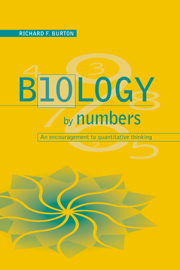Book contents
- Frontmatter
- Contents
- Preface
- A guide to the book
- 1 Putting two and two together
- 2 Units, formulae and the use of old envelopes: confronting some obstacles to quantitative thinking
- 3 Aspects of energy metabolism
- 4 Getting things in proportion
- 5 Perilous percentages, dangerous ratios
- 6 Building a trophic pyramid
- 7 Sodium in animals and plants
- 8 Exchanges of water and carbon dioxide
- 9 A geometric series
- 10 Introduction to logarithms
- 11 Bringing logarithms to life
- 12 Exponential relationships
- 13 Aspects of allometry
- 14 More on allometry, and on quantitative patterns in nature
- 15 How the abundance of food affects rates of feeding
- 16 The characterization of trees and other branching systems
- 17 Epilogue
- References
- Notes
- Index
12 - Exponential relationships
Published online by Cambridge University Press: 05 June 2012
- Frontmatter
- Contents
- Preface
- A guide to the book
- 1 Putting two and two together
- 2 Units, formulae and the use of old envelopes: confronting some obstacles to quantitative thinking
- 3 Aspects of energy metabolism
- 4 Getting things in proportion
- 5 Perilous percentages, dangerous ratios
- 6 Building a trophic pyramid
- 7 Sodium in animals and plants
- 8 Exchanges of water and carbon dioxide
- 9 A geometric series
- 10 Introduction to logarithms
- 11 Bringing logarithms to life
- 12 Exponential relationships
- 13 Aspects of allometry
- 14 More on allometry, and on quantitative patterns in nature
- 15 How the abundance of food affects rates of feeding
- 16 The characterization of trees and other branching systems
- 17 Epilogue
- References
- Notes
- Index
Summary
Basic mathematics
An exponent, as we have seen, is an index, a number or symbol denoting the power to which another quantity is raised, like the ‘n’ of 2n in Chapter 9. However, in talking of exponential relationships, most people refer to those containing expressions of the form ez, where e (equal approximately to 2.718) is raised to some power, in this case z. So far, I have no more than alluded to the fact that some of the relationships of Chapters 9 and 11 are exponential in nature. This is because it seems to me that those people who are uneasy with logarithms are even more troubled by the idea of that irrational number we call e. If that is right, the problem is probably more one of unfamiliarity than of difficulty. This chapter starts by dealing with mathematical aspects of exponential relationships and concludes with some biological examples. Most exponential relationships encountered in biology have to do with time courses.
At this point I must comment on what might seem like an inconsistency in my approach. In treating logarithms I concentrate on those to the base 10, with little space given to natural logarithms (i.e. those to the base e). Now, in treating exponentials, I emphasize expressions containing ez, even though all could be re-formulated in terms of 10z (or even 2Z). This inconsistency is fairly general in the biological literature for which I aim to prepare the reader.
- Type
- Chapter
- Information
- Biology by NumbersAn Encouragement to Quantitative Thinking, pp. 124 - 132Publisher: Cambridge University PressPrint publication year: 1998



